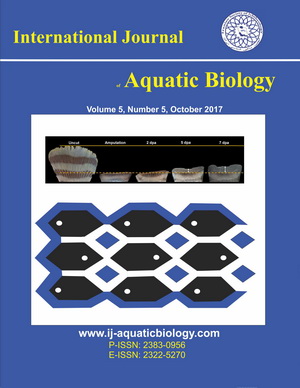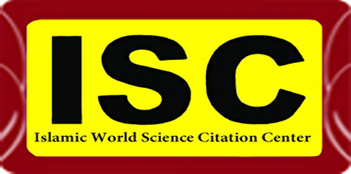Cloning and expression analysis of hif-2? gene in cobia (Rachycentron canadum) under hypoxia stress
Downloads
Hypoxia-inducible factor 2? (hif-2?) is a critical regulator of hypoxia response and plays a vital role in hypoxia stress in the organism. To understand the regulatory role of hif-2? in response to hypoxia stress in juvenile cobia (Rachycentron canadum), hif-2? was cloned using Rapid Amplification of cDNA Ends (RACE) technology. The full length of hif-2? is 4021 bp, with 2634 bp open reading frame (ORF), 5' non-coding region (5'UTR), 285 bp, 3' non-coding region (3'-UTR), 1102 bp, and encoding 877 amino acids. The encoded protein contains the HLH (Helix-loop-helix) domain (amino acids 20-75), the PAS (PER-ARNT-SIM) domain (amino acids 91-157 and 237-303), and the PAC (PAS Associated C-terminal) domain (amino acids 309-352). The results of phylogenetic tree analysis showed that hif-2? in cobia clustered with hif-2? in Echeneis naucrates and were closely related. Real-time fluorescence quantitative PCR (qRT-PCR) was used to analyze the expression of hif-2? in nine different tissues of cobia and the expression of hif-2? mRNA in the liver and gill under hypoxia stress. The results suggested that the hif-2? was expressed in all tissues of the cobia, with higher expression in the liver and gill. Under hypoxia stress, the expression of the hif-2? in the liver and gill was tissue-specific. In liver tissues, hif-2? expression was significantly higher than that of the control at 14 and 28 days. In gill tissues, hif-2? expression decreased at 7, 14, and 28 days and was lowest at 14 day. The results suggest that hif-2? plays a vital role in hypoxic stress in cobia and may provide basic information for studying the molecular genetic mechanism of hypoxia tolerance in cobia.
Downloads
Abdel-Tawwab M., Monier M.N., Hoseinifar S.H., Faggio C. (2019). Fish response to hypoxia stress: growth, physiological, and immunological biomarkers. Fish Physiology and Biochemistry, 45(3): 997-1013.
Alrezk R., Suarez A., Tena I., Pacak K. (2018). Update of pheochromocytoma syndromes: genetics, biochemical evaluation, and imaging. Frontiers in Endocrinology, 9: 515.
Bruick R.K. (2003). Oxygen sensing in the hypoxic response pathway: regulation of the hypoxia-inducible transcription factor. Genes and Development, 17(21): 2614-2623.
Cai X.L., Zhou Z.W., Zhu J.J., Liao Q., Zhang D.W., Liu X., Wang J., Ouyang G., Xiao W.H. (2020). Zebrafish Hif3? modulates erythropoiesis via regulation of gata1 to facilitate hypoxia tolerance. Development, 147(22): dev185116.
Chen N., Chen L.P., Zhang J., Chen C., Wei X.L., Gul Y., Wang W.M., Wang H.L. (2012). Molecular characterization and expression analysis of three hypoxia-inducible factor alpha subunits, HIF-1?/2?/3? of the hypoxia-sensitive freshwater species, Chinese sucker. Gene, 498(1): 81-90.
Chen S.X., Wang P.F., Ou Y.J., Li J.E., Wen J.F., Wang W., Xie M.J. (2017). Acute and chronic hypoxia effect on gills of golden pompano (Trachinotus ovatus). South China Fisheries Science, 13(1): 124-130.
Chen X.M., Liu J.Y., Zhang J.C., Yuan R.P., Qian J.H. (2016). Single nucleotide polymorphisms in catalase gene and their association with resistant hypoxia traits in Litopenaeus vannamei. Journal of Guangdong Ocean University, 36(6): 16-20.
Deng J., Zhang X., Yu S.S. (2017). Advances in differential roles of HIF-1? and HIF-2? in the pathogenesis of hypoxic pulmonary hypertension. Chinese Pharmacological Bulletin, 33(1): 10-13.
Fan B.H., Luo Y.S., Li Y., Wu M.L., Guo Q.J., Liu Y.J. (2018). Experimental study on the regulation of ERCC1 gene in gastric cancer BGC823 cells by HIF-2?. Chinese Clinical Oncology: Home, 23(4): 298-304.
Feng X., Yu X.M., Pang M.X., Tong J.G. (2019). Molecular characterization and expression regulation of the factor-inhibiting HIF-1 (FIH-1) gene under hypoxic stress in bighead carp (Aristichthys nobilis). Fish Physiology and Biochemistry, 45(2): 657-665.
Guo Z.X., Zeng Z.Q., Huang J.S., Wang W.Z., Li H.J., Chen G. (2020). Effects of acute hypoxia on oxidative stress, energy utilization and carbohydrate metabolism in liver of large-sized juvenile cobia (Rachycentron canadum). Journal of Guangdong Ocean University, 40(3): 134-140.
Huang C., Wang H., Bai Y., Zhou S., Zhang L. (2017). Molecular cloning, characterization and expression analysis of HIF-2? in yellow catfish (Pelteobagrus fulvidraco) under hypoxia stress. Fish Physiology and Biochemistry, 43(3): 945-956.
Huang J.S., Amenyogbe E., Yang L.T., Wang Z.L., Chen G., Wang W.Z., Zhang J.D. (2022). Cloning and expression analysis of hif-1? and downstream genes during hypoxic stress in cobia (Rachycentron canadum). Aquaculture International, 30(2): 803-824.
Jiang H.P., Zhang C., Wang C.C., Xu Q.H. (2015). Cloning of HIF1B and HIF2A genes and their expressions response to hypoxia in Gymnocypris dobula and Schizothorax prenanti. Freshwater Fisheries, 45(5): 11-18.
Kim C.H., Park C.J., Kim E.J., Nam Y.K. (2021). Transcriptional modulation patterns of abalone Haliotis discus hannai hypoxia inducible factor-1? (HIF-1?) in interdependent crosstalk between hypoxia, infection, and environmental stresses. Aquaculture Report, 19: 100566.
Li X., Zhu Y., Zhang D., Li D., Li L. (2017). Cloning, characterization and expression analysis of hypoxia-inducible factor-2? in the grass carp, Ctenopharyngodon idellus. Fish Physiology and Biochemistry, 43(3): 869-880.
Lin X.H., Ye M.H., Seatan W., Pan Y.Y., Chen F.Y., Huang Y., Zhu C.H., Li G.L., Tian C.X. (2020). Sequence characteristics and mRNA expression analysis of the phds gene family in silver sillago (Sillago sihama) under hypoxia stress. Journal of Guangdong Ocean University, 40(6): 1-8.
Liu F., Liu W., Wu Q., Yang Y.F., Hou C.R. (2011). Genetic cloning of hypoxia induciblefactor-2? in high altitude hypoxicadaptation species plateau pika (Ochotona curzoniae). China High Altitude Medicine and Biology, 32(3): 151-154+158.
Liu H.H., He J.Y., Chi C.F., Gu Y.F. (2015). Identification and analysis of icCu/Zn-SOD, Mn-SOD and ecCu/Zn-SOD in superoxide dismutase multigene family of Pseudosciaena crocea. Fish and Shellfish Immunology, 43(2): 491-501.
Liu Z.Y., Zhao X.Y., Jiang X.Y., Zou S.M. (2018). Transcription of blunt snout bream (Megalobrama amblycephala) HIF3? and its localization in the nucleus under both normoxic and hypoxic conditions. Biochemical and Biophysical Research Communications, 500(2): 443-449.
Lu Z.F., Huang H., Huang X.M., Huang W.Z. (2022). Effects of hypoxic stress on antioxidant and energy metabolism of hybrid grouper (Epinephelus fuscoguttatus?×Epinephelus lanceolatuso?). Journal of Guangdong Ocean University, 42(1): 13-19.
Mu W.J., Wen H.S., Li J.F., He F. (2015). HIFs genes expression and hematology indices responses to different oxygen treatments in an ovoviviparous teleost species Sebastes schlegelii. Marine Environmental Research, 110: 142-151.
Petousi N., Croft Q.P.P., Cavalleri G.L., Cheng H.Y., Formenti F., Ishida K., Lunn D., McCormack M., Shianna K.V., Talbot N.P., Ratcliffe P.J., Robbins P.A. (2014). Tibetans living at sea level have a hyporesponsive hypoxia-inducible factor system and blunted physiological responses to hypoxia. Journal of Applied Physiology, 116(7): 893-904.
Rahman M.S., Thomas P. (2007). Molecular cloning, characterization and expression of two hypoxia-inducible factor alpha subunits, HIF-1alpha and HIF-2alpha, in a hypoxia-tolerant marine teleost, Atlantic croaker (Micropogonias undulatus). Gene, 396(2): 273-282.
Rojas D.A., Perez-Munizaga D.A., Centanin L., Antonelli M., Wappner P., Allende M.L., Reyes A.E. (2007). Cloning of hif-1? and hif-2? and mRNA expression pattern during development in zebrafish. Gene Expression Patterns, 7(3): 339-345.
Rytkönen K.T., Akbarzadeh A., Miandare H.K., Kamei H., Duan C., Leder E.H., Williams T.A., Nikinmaa M. (2013). Subfunctionalization of cyprinid hypoxia?inducible factors for roles in development and oxygen sensing. Evolution, 67(3): 873-882.
Shen R.J., Jiang X.Y., Pu J.W., Zou S.M. (2010). HIF-1? and-2? genes in a hypoxia-sensitive teleost species Megalobrama amblycephala: cDNA cloning, expression and different responses to hypoxia. Comparative Biochemistry and Physiology Part B, 157(3): 273-280.
Tian H., Mcknight S.L., Russell D.W. (1997). Endothelial PAS domain protein 1 (hif-2?), a transcription factor selectively expressed in endothelial cells. Genes and Development, 11(1): 72-82.
Wang M., Liao S.J., Fu Z.N., Zang X.C, Yin S.W., Wang T. (2022). iTRAQ-based quantitative proteomic analysis of Pelteobagrus vachelli liver in response to hypoxia. Journal of Proteomics, 51: 104425.
Wang W.Z., Huang J.S., Zhang J.D., Wang Z.L., Li H.J., Amenyogbe E., Chen G. (2021). Effects of hypoxia stress on the intestinal microflora of juvenile of cobia (Rachycentron canadum). Aquaculture, 536: 736419.
Wang W.Z., Zeng Z.Q., Huang J.S., Guo Z.X., Li H.J., Chen G. (2021). Hypoxia stress on growth, serum biochemical and non-specific immune indexes of juvenile cobia (Rachycentron canadum). Acta Oceanologica Sinica, 43(2): 49-58.
Wang W.Z., Zeng Z.Q., Huang J.S., Guo Z.X., Li H.J., Chen G. (2020). Effects of hypoxia stress on antioxidation, immunity and energy metabolism of juvenile cobia, Rachycentron canadum. Journal of Guangdong Ocean University, 40(5): 12-18.
Wang Z., Hu J., Zhong L., Cheng Y., Huang X. (2017). Cloning, characterization and expression analysis of hypoxia-inducible factor-2? in largemouth bass (Micropterus salmoides). Gene, 622: 1-7.
Wu R.R., Chao Y., Zhao Y.L., Chen Q.C., Zheng Z.Q., Xia M.Z., Qi D.L. (2019). Molecular evolution and hypoxia-induced mRNA expression of Hif-? in schizothoracine fish. Acta Laboratorium Animalis Scientia Sinica, 27(4): 433-443.
Xiao W.H. (2015). The hypoxia signaling pathway and hypoxic adaptation in fishes. Science China Life Sciences, 58(2): 148-155.
Xu T., Cao H., Yang D. (2019). Cloning, characterization, and expression analysis of the hypoxia-inducible factor-2? gene in the Chinese sturgeon (Acipenser sinensis). Fish Physiology and Biochemistry, 45(4): 1291-1301.
Yang Y.T., Dong Z.D., Chen X., Wang Z., Zhang D.W., Liang L.Q., Mu W.J. (2022). Molecular characterization and expression analysis of hypoxia-inducible factor-1?, factor-2?, and factor-3? and physiological response to hypoxia exposure in Amur minnow (Phoxinus lagowskii). Aquaculture International, 30: 607-632.
Zhang G.S., Zhao C., Wang Q.T., Gu Y.C., Li Z.C., Tao P.F., Chen J.W., Yin S.W. (2017). Identification of HIF-1 signaling pathway in Pelteobagrus vachelli using RNA-Seq: effects of acute hypoxia and reoxygenation on oxygen sensors, respiratory metabolism, and hematology indices. Journal of Comparative Physiology B, 187(7): 931-943.
Zhang G.W., Wu B., Liu Z.H., Zhou L.Q., Sun X.J., Zhao Q., Yang A.G. (2019). Structural characteristics of HIF-1a from Scapharca broughtonii and expression analysis under hypoxia. Journal of Fishery Sciences of China, 26(4): 646-656.
Zhang J., Ren J.L., Shen L.Y., Xiang Z., Chen X.Q., Cao Y.B., Du J.Z. (2014). The cloning of HIF-2? gene and hydroxylation assay of HIF-2? ODD domain in naked carp from Qinghai lake. Chinese Journal of Applied Physiology, 30(5): 410-412.
Zhang K.Q., Chang Z.C., Wen H.S., Li J.F., Qi X., Zhang X.Y., Li Y. (2020). Sequence analysis and hypoxia-induced expression of hypoxia inducible factors (hifs) of Lateolabrax maculatus. Journal of Ocean University of China (Natural Science Edition), 50(1): 39-47.
Copyright (c) 2025 International Journal of Aquatic Biology

This work is licensed under a Creative Commons Attribution 4.0 International License.








